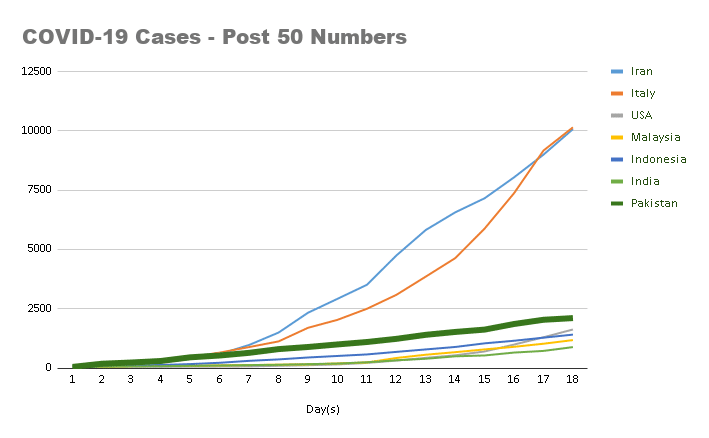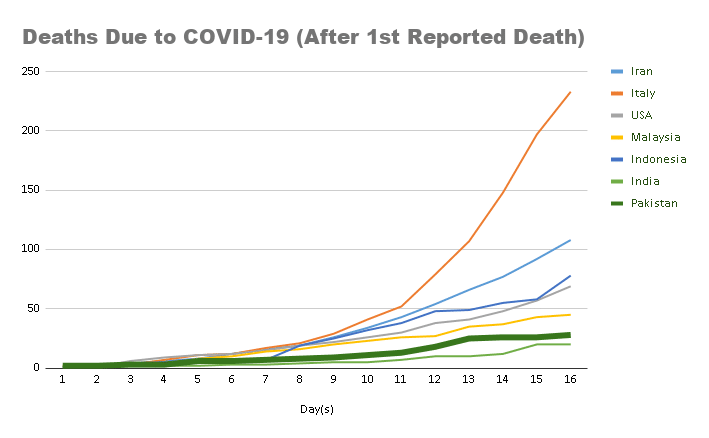Covid-19 is beginning to tighten its grip around Pakistan.
It became clear last month that the threat was real and there was no escaping it. Like pretty much every country around the world, Pakistan must have had initially thought (read: hoped) that Coronavirus would be contained within the geographical limits of Hubei, the once epicenter of the outbreak. And not wrongly so, because various similar outbreaks in the past didn’t go global.
However, it became evident around mid-to-end of February or early March that Coronavirus was different. It was not a matter of if but when Pakistan would be battling the disease.
Unfortunately, Taftaan became the flashpoint and although other international inflows also contributed, Iran-returners became the major source of Coronavirus in the country.
It was around mid-March that Pakistani authorities mobilized in a real sense to contain the highly contagious virus.
Since then, we have seen lock-downs, restriction on movement, sealed areas, closure of non-essential business activities and whatnot.
However, for many, it’s still unclear what Pakistan’s strategy is to contain the spread of virus. Is it working, what modeling have we used to devise the strategy, if its implemented anywhere else or not and mainly: do we have a contingency plan or not?
We also need to know if the strategy is data-driven. What scientific model was used to make decisions and why aren’t all provinces seemingly not aligned in terms of strategy and the plan to contain the virus?
These are questions that everyone is asking, particularly the opposition parties and those who are unhappy with the results of current plan of action.
Understanding Pakistan’s Strategy to Fight the Pandemic
First things first, we need to understand the plan for containing the virus, before we jump towards the results or gauge if it’s working or not.
Unlike what you see on TV, Pakistan isn’t locked down.
Yes, non-essential businesses are closed, but otherwise, movement is possible. While it’s not at the levels before coronavirus, social activity is still happening.
But.
Then there comes a but, which holds the key to how the Pakistani government is planning to contain the virus.
There’s no strict lock-down, but then there are pockets (read identified hotspots) that are strictly sealed. No one is allowed to go in or come outside such hotspots.
Such sealed areas are those identified colonies/societies where Coronavirus cases have emerged. Once tested positive, the whole area is cordoned-off, with military deployment and everything is shut down.
We have examples of Bara-Kahu (in Islamabad), Manga (from District Mardan), Raiwind, Civil Lines in Karachi and the list goes on.
This appears to be the plan: seal smaller hotspots to contain the virus, and avoid large scale shutdowns to make sure that poor and under-privileged people don’t end up starving.
Those who are against a rather flexible lockdown think that this strategy won’t work. Their fears are valid, especially if you look at death rate in Europe and USA.
But let’s take a look at numbers to see how Pakistan’s doing with its selective lock-down strategy.
In this comparison, we picked numbers from various countries after they reached 50 COVID-19 cases mark, including Iran, Italy, USA (most hit countries) as well as Malaysia, Indonesia and India.
(we omitted duration when cases were under 50 because it took very long for some countries to reach even 10 positive Coronavirus cases)
Clearly Pakistan is somewhere in the middle of the graph, showing that we aren’t doing too poorly.
As for why we aren’t doing as much as testing as possible, it comes down to capacity.
In fact, no one has that sort of capacity as South Korea or China. If you are familiar with how bad the testing situation in US or UK is, then it would be comprehensible that above numbers represent a fair picture, if not the entire picture.
Also to note, Pakistan comes in top 15 countries to have tested Coronavirus cases per million population. But then again, yes we performed lesser numbers of tests, like majority of other nations.
Now let’s look at number of fatalities, as they are reported only for confirmed cases. They will also reflect on how Pakistan is faring with its limited lock down strategy.
Below is the graph:
This is a comparison of COVID-19 related deaths for various countries, after their first reported death.
Here Pakistan is doing better than all, except India.
These graphs show that Pakistan’s strategy is currently working, and may remain successful until there’s a major shift in the situation.
Pakistan’s Strategy is At Least Slowing the Spread
Another fear is that Pakistan’s strategy of limited lock-downs is only slowing down the spread and the situation will eventually get out of control.
Since we cannot eliminate entirely coronavirus from the country, we will keep finding new hotspots and may some of them become much worse than others.
Pakistani officials are hoping that it won’t be the case. They believe that since the spread is contained, or at least slowed-down, and every new case is actively pursued, it is less likely for the virus to get out of control.
Is this is the Optimum Plan? Has it Been Tested Anywhere with Proven Results?
There’s no proven strategy because the world simply hasn’t seen a pandemic like this is over 100 years.
Each country has devised its own way of dealing with the Coronavirus. Their respective plans take into account local dynamics and scientific consensus.
Generally, there are two major approaches. One is a complete lock-down, and second is to test everyone.
Most nations have resorted to lock-downs, except a few who went with the testing approach.
For example, the US adopted lock-downs and has extended them till April 30. It’s the same case with UK, which foresees at least 6 months of closure before life can even begin to normalize.
Other countries like Spain, France, Iran, Saudi Arabia, and India, among others, have also imposed widespread lockdowns, with no end in sight. How these countries will control the spread after the restrictions are gradually lifted is anybody’s guess.
The only countries that have recorded some success in bringing local transmissions to zero are China, the onetime epicenter of the pandemic, and South Korea. While China succeeded in flattening the curve through stringent shutdown and aggressive testing measures, South Korea showed that it is possible to contain the coronavirus without shutting down the economy.
South Korea’s success lies in timely intervention, large-scale testing, and aggressive contact tracing, isolation, and surveillance.
The country used the tools and practices for aggressive contact tracing that it had developed during the MERS outbreak. Security camera footage, credit card records, even GPS data from cars and cellphones were used to retrace patients’ movements.
Then there is Sweden, which is following a far more relaxed coronavirus strategy. Unlike its immediate neighbors Denmark, Finland, and Norway, Sweden has not closed its borders or its schools. Neither has it closed non-essential businesses or banned gatherings of more than two people as U.K. and Germany did.
Sweden is winning its battle against the pandemic through two key approaches: excellence in remote working and promotion of self-responsibility. Thanks to a tech-savvy workforce and a business culture that has long promoted flexible and remote working practices, work hasn’t stopped in Sweden. And instead of strict rules, there are guidelines for the public for staying safe without disrupting life.
Conclusion
The most developed countries in the world and the best healthcare systems are toppling before our very eyes. It’s not business as usual and the situation is rapidly evolving.
In such situations, you do your best based on local dynamics and available resources.
Contrary to claims, Pakistan’s plan is clearly based on data. And I can confirm that specialized individuals with data science and artificial intelligence are working with the government to devise this strategy.
While I can’t reveal a lot of details, but I can tell that Pakistan’s plan is based on authentic pandemic modeling, however, it has all the possibilities to be wrong about the numbers, which is the case with every model adopted around the world.
But at least Pakistani government isn’t basing its decisions on gut feelings, which is a relief.
While the current plan seems to be working, it’s clearly not fool-proof.
We can hope that slowing down the spread will ultimately contain Coronavirus until a vaccine or a cure is developed.
But since our plan isn’t proof plan, there must be a back-up strategy in place and that possibly would be a complete lock-down, like in Italy, or in Spain or like they had in Hubei.
But that’s going to be when things are out of control, and it might end up being too late.
We just hope that we don’t see such a situation.



























